Table of Contents
Statue of Liberty
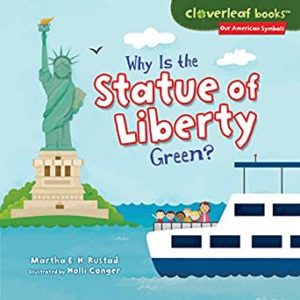 |
By Martha E.H. Rustad, Why Is the Statue of Liberty Green? (Millbrook Press, 2014) – through the medium of a class field trip – covers the history of the Statue of Liberty, plus assorted interesting facts (it hasn’t always looked green) for ages 4-8. |
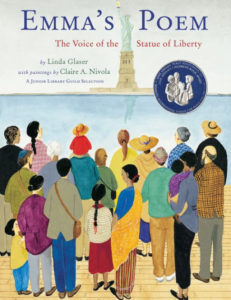 |
By Linda Glaser, Emma’s Poem (Houghton Mifflin Harcourt, 2013) is the picture-book story of Emma Lazarus and the poem that gave a voice to the Statue of Liberty. (“Give me your tired, your poor/Your huddled masses yearning to breathe free…”) For ages 4-8.
|
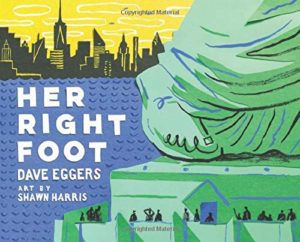 |
The Statue of Liberty isn’t standing still. Her right foot is lifted, as if she’s striding out to sea. Why? Dave Eggers’s Her Right Foot (Chronicle Books, 2017), a picture-book history of both the statue and of immigration, ventures a guess – she’s stepping forward to welcome the next wave of immigrants, because immigration goes on and on. For ages 4-8. |
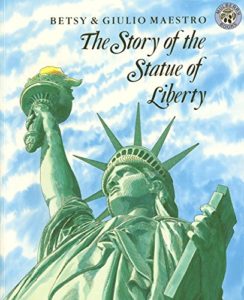 |
By Betsy and Giulio Maestro, The Story of the Statue of Liberty (HarperCollins, 1989) is a straightforward picture-book account of the statue’s inception, creation, and installation, and an explanation of its symbolism for ages 5-9.
|
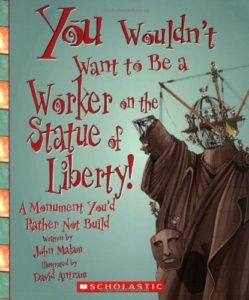 |
By John Malam, You Wouldn’t Want to Be a Worker on the Statue of Liberty! (Franklin Watts, 2017), in the popular You Wouldn’t Want to Be series, is informational, well-researched, and often hilarious, with cartoon-style illustrations. Written in the second person, which makes for a catchy interactive read. (“You’ll be handing heavy materials and you can’t be afraid of heights.”) For ages 8-11. |
 |
Build your own! In the LEGO Architecture series, the Statue of Liberty Building Kit has 1685 pieces. Suggested for ages 16 and up. For younger builders ages 6 and up, see this 39-piece version.
|
 |
You become the Statue of Liberty! See these instructions for making your own crown and torch!
|
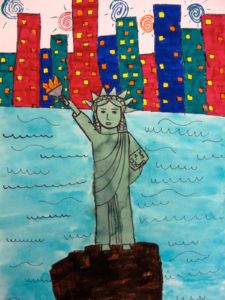 |
From Deep Space Sparkle, see these art lessons for making Statue of Liberty portraits. Targeted at age 10 or so.
|
Immigrants Tell Their Stories
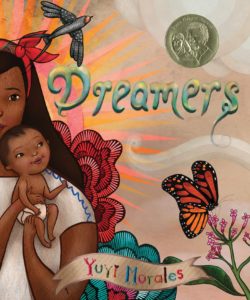 |
By Yuyi Morales, Dreamers (Neal Porter Books, 2018) is a gorgeously illustrated picture-book story/memoir of the gifts immigrants bring with them and the things they discover in their new country. Such as the library: “Suspicious./Improbable./Unbelievable./Surprising.” A multiple award-winner for ages 4-8. |
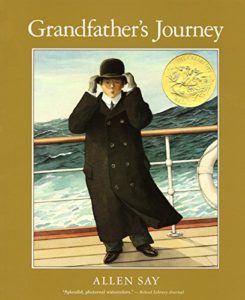 |
By Allen Say, Grandfather’s Journey (Sandpiper, 2008) – based on the experience of Say’s grandfather – is the story of a young Japanese man who settles in California and then returns to Japan, and his love for both of the places that he calls home. For ages 4-8.
|
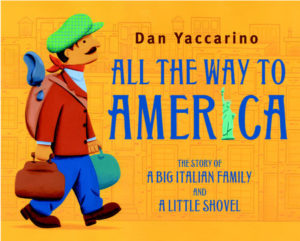 |
Dan Yaccarino’s picture book All the Way to America (Knopf, 2012) tells how his great-grandfather arrived on Ellis Island from Italy with a little shovel and some words of advice from his parents: “Work hard, but remember to enjoy life, and never forget your family.” For ages 5-9.
|
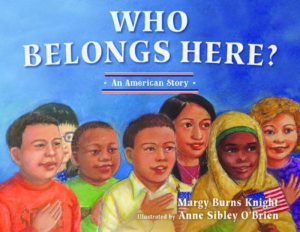 |
By Margy Burns Knight, Who Belongs Here? (Tilbury House, 2018) centers around the story of Nary, a Cambodian boy, and his grandmother, who fled the Khmer Rouge after the deaths of his parents – and now are having a hard time being accepted in America. Some kids in Nary’s class feel he should go back where he belongs. But what if everybody were made to return to their countries of origin? Who would be left? For ages 7-13. |
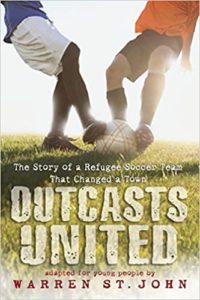 |
Warren St. John’s Outcasts United (Ember, 2013) is the inspirational story of the Fugees, a diverse youth soccer team made up of players from Clarkston, Georgia, a refugee resettlement center, under the guidance of their Jordanian female coach. For ages 12 and up.
|
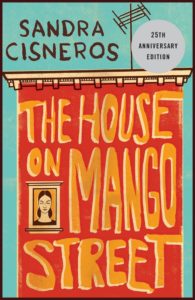 |
By Sandra Cisneros, the award-winning The House on Mango Street (Vintage, 1991) is the story of Esperanza, a 12-year-old Latina, growing up in the poor Hispanic quarter of Chicago, written in a series of vignettes. Based in part on the author’s own experiences. A wonderful read – and a standard on many reading lists – for ages 12 and up.
|
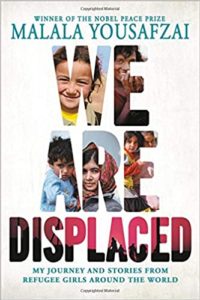 |
By Malala Yousafzai, We Are Displaced (Little, Brown, 2019) is a collection of true stories about the experiences of refugee girls from around the world, from the Middle East to South America, Africa to Asia. Included is the story of Malala herself, who survived an attempted assassination by the Taliban as a teenager in Pakistan, and eventually became a displaced person due to Taliban violence. For ages 13 and up.
|
Fiction: Younger Readers
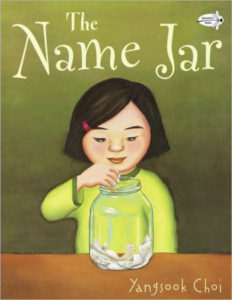 |
In The Name Jar by Yangsook Choi (Dragonfly Books, 2003), Unhei has just moved to America from Korea and is worried that her new classmates will not be able to pronounce her name. Instead, she tells the class that she will soon pick a name – and the class creates a name jar, filled with possible names for her to choose. Ultimately, however, she keeps her own – and teaches her classmates how to say it. For ages 3-7. |
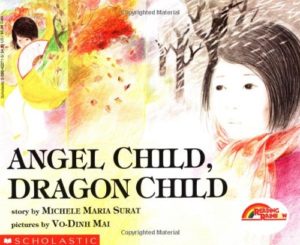 |
By Michele Maria Surat, Angel Child, Dragon Child (Scholastic, 1989) is the story of Ut, who comes to America alone from Vietnam, and struggles to adjust to her new life. “’Why are you so mean to me?’ wondered Ut. ‘Because you are different. You wear funny clothes and you talk with funny words,’ answered Raymond.” For aged 3-8.
|
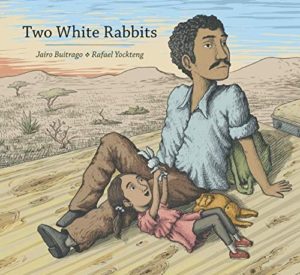 |
In Jairo Buitrago’s Two White Rabbits (Groundwood Books, 2015), a little girl, her two stuffed rabbits, and her father are making the difficult journey from Central America to the United States. For ages 4-7.
|
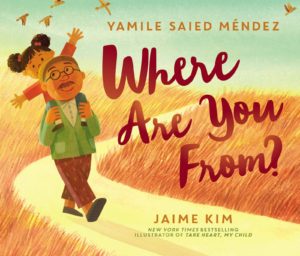 |
By Yamile Saied Mendez’s Where Are You From? (HarperCollins, 2019) celebrates diversity by showing that “Where are you from?” is not a simple question. Also available in a Spanish edition. For ages 4-8.
|
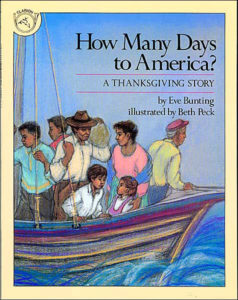 |
In Eve Bunting’s How Many Days to America? (Clarion, 2015), after the soldiers come, a family flees their country with nothing but a change of clothes and takes a small boat to America – where they arrive on Thanksgiving Day. For ages 4-8.
|
 |
By the brilliant Peter Sis, the title character of Madlenka (Square Fish, 2010) tours her multicultural city block, visiting the French baker, the Indian news vendor, the Latin American grocer, and more, sharing with all the news of her loose tooth. For ages 4-8.
|
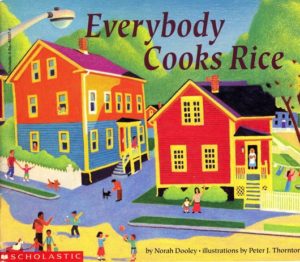 |
In Norah Dooley’s Everybody Cooks Rice (Carolrhoda, 1991), Carrie travels through her multi-ethnic neighborhood looking for her brother, who is late to dinner – and discovering the many different ways in which different immigrant families cook rice. Carrie samples meals from Barbados, Haiti, Puerto Rico, Vietnam, China, and India, before ending up at home for an Italian meal of risi e bisi. Also by Dooley in the same format, see Everybody Bakes Bread (1995), Everybody Serves Soup (2004), and Everybody Brings Noodles (2005). |
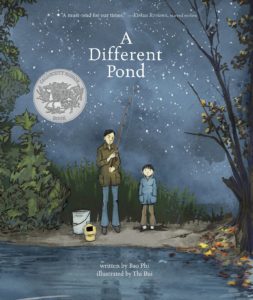 |
In Bao Phi’s graphic novel A Different Pond (Capstone, 2017), a father and son share an early-morning fishing trip to a pond in Minneapolis. While they fish, the father tells his son the story of his life as a boy, fishing at a different pond in Vietnam. For ages 4-8.
|
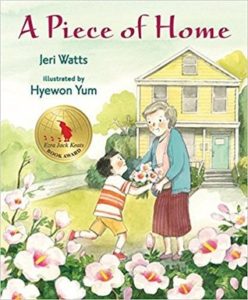 |
In Jeri Watts’s A Piece of Home (Candlewick, 2016), Hee Jun and his family have moved from Korea to West Virginia, and he’s had a hard time fitting in – until a classmate invites him home and he sees a familiar flower in their garden. They give him a shoot so that he and his grandmother can plant “a piece of home” in their own new garden. For ages 4-8.
|
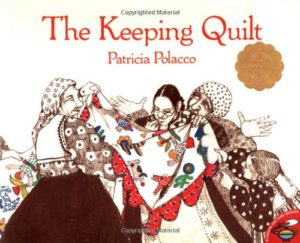 |
In Patricia Polacco’s The Keeping Quilt (Simon & Schuster, 2001), the quilt, made from scraps of old clothes from family back home in Russia, in passed down through generations, serving as a Sabbath tablecloth, a wedding canopy, and a blanket for newborn babies. For ages 4-8. |
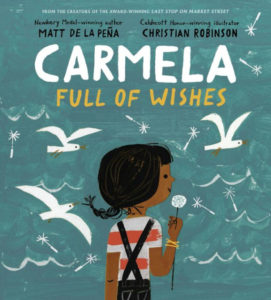 |
In Matt de la Pena’s Carmela Full of Wishes (G.P. Putnam’s Sons, 2018), 7-year-old Carmela, on her birthday, sets off with her older brother to run the family errands – and on the way finds a fluffy dandelion that she plans to use to make a wish. (Find her mom a job at a posh hotel? Get her dad American citizenship, so he can return home?) Instead, she falls off her scooter and crushes the flower – but all is not lost; her big brother finds her an entire sky filled with wishes. For ages 4-8. |
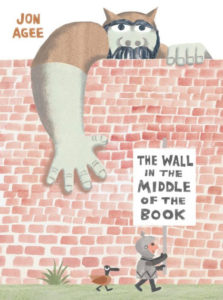 |
Jon Agee’s The Wall in the Middle of the Book (Dial, 2018) is a clever lesson about misjudging others. A brick wall runs right through the book. On one side, a knight with a ladder insists that his side of the wall is safe, protected from the fearsome rhinos, tigers, and ogres on the other side. However, as a flood (with crocodiles) threatens the knight’s side of the wall, it turns out that ogres aren’t fearsome at all. A wonderful read and a lesson in not making snap judgments about others for ages 4-8. |
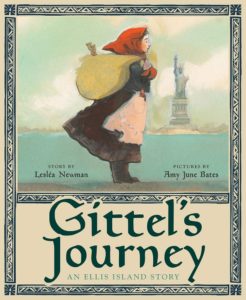 |
By Leslea Newman, Gittel’s Journey (Harry N. Abrams, 2019) is the story of nine-year-old Gittell who, when her mother’s eye infection prevents her from emigrating, ends up traveling to Ellis Island alone. Worse, the ink has run on the scrap of paper with cousin Mendel’s New York address, so Gittell has no idea where to go. For ages 5-8.
|
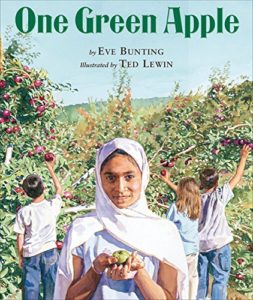 |
In Eve Bunting’s One Green Apple (Houghton Mifflin Harcourt, 2006), Farah, a young Muslim immigrant, feels out of place in her new country, especially since she speaks little English – until a trip to an apple orchard and shared cider-making with her classmates proves that all have much in common. It takes all kinds of apples to make cider. For ages 5-9.
|
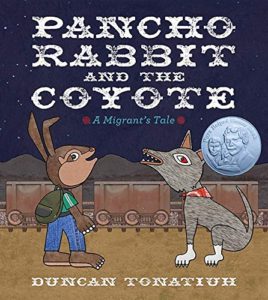 |
In Duncan Tonatiuh’s Pancho Rabbit and the Coyote (Harry N. Abrams, 2013), Pancho Rabbit is off to El Norte to find his father, who is late returning from the carrot and lettuce fields. To get there, however, he has to cross the border, which involves dealing with a guide in the form of a hungry coyote, a river, a fence, and a tunnel guarded by uniformed, bribe-taking snakes. The modern-day Mexican immigrant experience with folktale animals. For ages 6-9. |
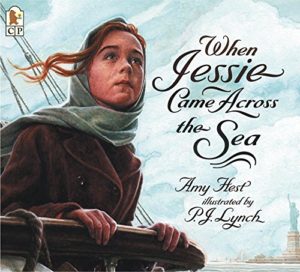 |
In Amy Hest’s When Jessie Came Across the Sea (Candlewick, 2003), 13-year-old Jessie is leaving her shtetl in Eastern Europe for America, leaving her beloved grandmother behind. For ages 6-9.
|
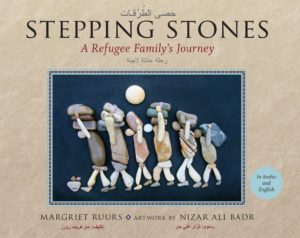 |
By Margriet Ruurs, Stepping Stones (Orca, 2016) is the picture-book story of Rama and her family, forced to flee Syria and seek safety in Europe in the wake of the raging civil war. Gorgeously illustrated with the stone artwork of Syrian artist Nizar Ali Badr. For ages 6-9. Try some pebble art of your own. See some ideas here. |
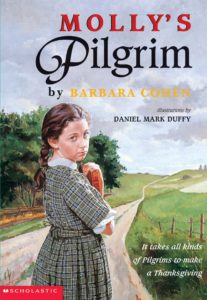 |
In Molly’s Pilgrim (HarperCollins, 2018) by Barbara Cohen, third-grader Molly, a Russian Jewish immigrant who struggles with English, is teased mercilessly at school – and things are made even worse when the children are asked to make pilgrim dolls for a Thanksgiving celebration, and Molly brings one dressed as a Russian peasant. It turns out, however, that there are many different kinds of pilgrims. For ages 6-10. There’s a short (24-minute) movie version of the book in which author Barbara Cohen has a flashing appearance as a school crossing guard. |
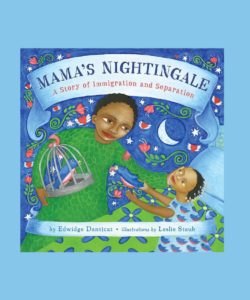 |
In Edwidge Danticat’s Mama’s Nightingale (Dial, 2015), Saya’s Haitian mother has been sent to a prison for undocumented immigrants and Saya’s only comfort is the stories of the nightingale that her mother records for her on cassette tapes. Finally Saya writes a story of her own, which catches the attention of a newspaper reporter. A book about the pain of the immigrant experience and the power of story for ages 6-10. |
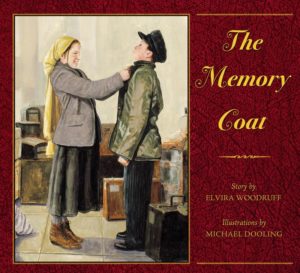 |
In Elvira Woodruff’s The Memory Coat (Scholastic, 1999), Rachel’s Jewish family is fleeing persecution in Russia, along with Rachel’s orphaned cousin Grisha. Grisha clings to the ragged wool coat that his mother made for him – but when the coat is marked by an Ellis Island inspector as rejecting Grisha for admission to America, Rachel quickly turns the coat inside out, allowing him to stay with the family. For ages 7-10. |
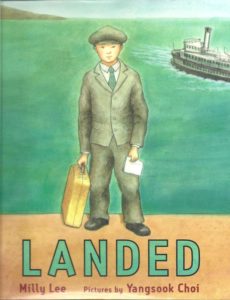 |
In Milly Lee’s Landed (Farrar, Straus & Giroux, 2006), 12-year-old Sun is worried that, because of the 1882 Chinese Exclusion Act, he will be unable to pass the test administered by officials on Angel Island and enter the United States from China. For ages 7-11.
|
